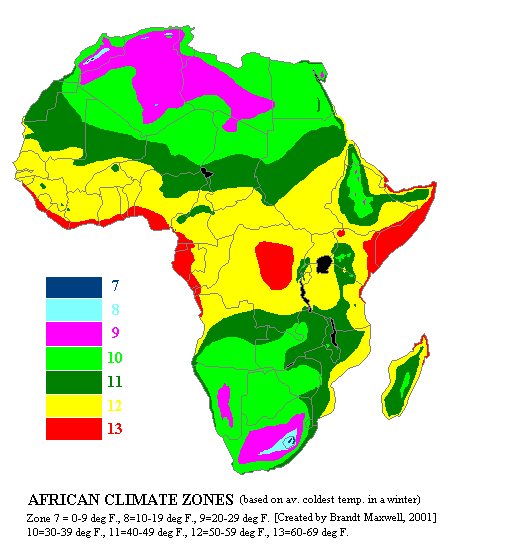Regional Guide - Kwazulu-Natal Coast - ZONE 11
This region stretches from Port Edward to Kosi Bay.
Rainfall: High summer rainfall.
Temperatures: Summer - hot and humid.
Winters - dry and mild.
I am very happy I found this information, knowing your planting zone can be very useful when your are planning your garden and flower bed areas. When you order plants online or through a catalogue it is very useful for you to know what will have the best success in your planting zone. Most plants are marked with a zone number.
Planting zones, hardiness zones and gardening zones are all names for the same thing. USDA zones is another name for the same thing. Plants generally have a range of hardiness zones. The number, which corresponds to a zone shown, indicates the coldest areas in which the particular plant is likely to survive through an average winter.
So a plant might have a zone range of 4 to 8 (usually written as 4-8). This means that the plant should grow in any planting zone between 4 and 8, inclusive. The smaller the number, the colder the climate – just like a thermometer. So if you live in zone 3, a 4-8 plant will probably not make it through the winter. If you live in a warm planting zone like 10, then this plant will also not do well because of the heat. It does not want to grow in a zone warmer than 8. Note that these are not necessarily the areas in which it will grow best. Plants grown in a zone considerable higher than the zone with the minimum winter temperature will survive and might grow well but they are likely to behave differently.
Each zone is further divided in half to have an ‘a’ and a ‘b’, with ‘a’ being 5 degrees colder than ‘b’. To be honest, very few sources of plant information bother with the ‘a’ and ‘b’. They will just report the number.
These zones are provided as a guide and exceptions do occur.
 |
| Photo: Weekend Gardener |
These zones are approximations based on the average data. Your local climate can be warmer or colder, especially in higher elevation regions like the mountains.
 |
| Photo: Seeds for Africa |
While hardiness and heat zones are extremely helpful, they don’t tell the whole story. There are many other weather effects that can determine how well a plant will grow for you, including humidity, rainfall and wind. These maps were compiled based on average temperatures, so they don’t account for unusual weather patterns. Other factors that can’t be included on a large national map are the effects of soil and soil fertility, and the health of your plants in general.
Find your countries hardiness zone here
Which zone is your garden located in? Do you any specific problems with your climate?
I hope these tips have given you some inspiration! Till' next time xo
WHAT DO YOU THINK?






No comments:
Post a Comment